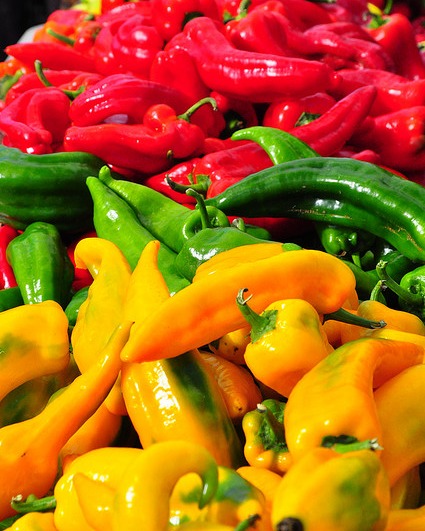 Chile crops just couldn’t take the heat from the February cold snap.Photo: Demetri MouratisWhat a difference a few days of aberrant weather can mean to our food security, our pocket books, and our penchant for hot sauce. The record freeze that hit the U.S. Southwest and Northern Mexico in early February is still affecting vegetable availability and food prices in general more than 6 weeks after the catastrophe. Restaurants across the U.S. are rationing peppers and tomatoes on their sandwiches and in their salsas. Prices for peppers have jumped as much as 50 percent, and for tomatoes by 15 percent, due to crop damages resulting from the worst freeze in southwestern North America since 1957.
Chile crops just couldn’t take the heat from the February cold snap.Photo: Demetri MouratisWhat a difference a few days of aberrant weather can mean to our food security, our pocket books, and our penchant for hot sauce. The record freeze that hit the U.S. Southwest and Northern Mexico in early February is still affecting vegetable availability and food prices in general more than 6 weeks after the catastrophe. Restaurants across the U.S. are rationing peppers and tomatoes on their sandwiches and in their salsas. Prices for peppers have jumped as much as 50 percent, and for tomatoes by 15 percent, due to crop damages resulting from the worst freeze in southwestern North America since 1957.
This binational region normally produces well over 90 percent of all winter vegetables eaten in the United States. The cold snap damaged fruits and leafy vegetables from the Imperial Valley of California and the Yuma area of Arizona, clear to Los Mochius and Culiacan in Sinaloa, Mexico.
Open fields in the region suffered damage on 85-90 percent of their peppers, tomatoes, cucumbers, and melons, while those in hoop houses and greenhouses varied in levels of damage from 60 percent to 80 percent, depending on the local microclimate.
And in Florida — the other winter source of these vegetables for American eaters — abnormally cold weather had already disrupted crop production over the previous two months prior to the freeze. As Gregg Biada, vice president of Global Fresh Import and Export told The Packer, a leading reporter of agri-business trends, “Things got really crazy … prices went through the roof.”
As a result, restaurants, grocery stores, food services, and salsa processing plants are having difficulty getting enough products within price ranges they can afford. And of course, the people who now have less access to and buying power for these vegetables are the poorest of the poor stranded on both sides of the border.
These vegetables and fruits normally provide Americans with vitamin C and other nutrients they require to stay resistant to illness during the winter and spring months. But if the crop varieties we plant on tens of thousands of acres lack resistance to the stresses generated by shifting weather patterns, our own bodies’ defense mechanisms may be compromised as well.
There is a deeper lesson to be learned from the out-of-season, unexpected freezes, unseasonable hailstorms, and recording-breaking heat waves that have prevailed these last few years: Farmers are facing ever-greater climatic uncertainty, and the chronically food insecure families hidden in our rural communities are the ones most likely to bear the brunt of these catastrophes causing seasonal food scarcity.
The February cold snap may have been the worst since 1957 in the desert borderlands, but it has reminded me that farmers must always prepare as best as we can for uncertainty. And one way to buffer ourselves from such extreme weather events is to diversify the varieties of peppers and tomatoes we grow, and places in which we grown them.
As an orchard keeper and chile grower, I lost hundreds if not thousands of dollars of trees and other perennials that I had selected for “normal conditions” in my region. I am relieved that most of my trees made it through the freeze, and this week, have even begun to show signs of new buds. However, I will be replanting with hardier varieties of fruit and nut trees this year, and more importantly, placing my chile peppers in the partial shade of larger “nurse plants” which can buffer them from both extreme heat and cold.
Most importantly, I am increasing the water-holding capacity of my soils to foster deeper rooting and less stress on the entire suite of plants I keep. Like all gardeners and farmers, I cannot predict the weather, but I can take steps to make my food production — and the larger food system — as resilient as it can possibly be.
Climate change is scrambling where the most optimal conditions for each vegetable variety will occur in the future. We now need to diversify our food production strategies and broaden our crop diversity if we ourselves are to “weather” such stresses.



